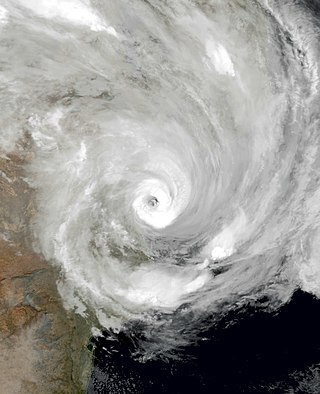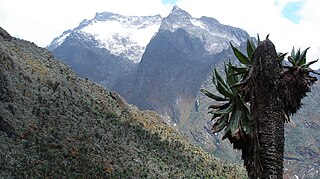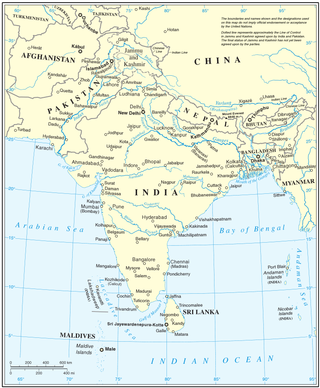
East Africa, Eastern Africa, or East of Africa, is the eastern subregion of the African continent. In the United Nations Statistics Division scheme of geographic regions, 10-11-(16*) territories make up Eastern Africa:

The Somali Flash Floods are a group of flash floods that occur annually in the country of Somalia. The floods are a result of the Gu rains, which is the monsoon like rainfall that comes every March in the region. Every year, in the period shortly after the Gu rains from March to July, flash floods hit the lower Jubba and lower Shabelle regions of Somalia. These flash floods cause devastation and destruction, causing casualties and displacement. In recent years, the effects of the floods have increased compared to past floods. This is due to Somali population increase and continuing lack of preparation mechanisms, and they may be exemplified by meteorological reasons as well.

Deep Depression ARB 01 was the second deadliest tropical cyclone worldwide in 2013 as well as the deadliest to affect Somalia in recorded history. The sixth tropical cyclone and third deep depression of the 2013 North Indian Ocean cyclone season, ARB 01 formed in the Arabian Sea on November 8. The cyclone subsequently strengthened into a deep depression before making landfall in the Puntland region of Somalia at peak intensity on November 11. After making landfall, the cyclone rapidly weakened over land and degenerated into a well-marked low-pressure area later on the same day.

The 2018 North Indian Ocean cyclone season was one of the most active North Indian Ocean cyclone seasons since 1992, with the formation of fourteen depressions and seven cyclones. The North Indian Ocean cyclone season has no official bounds, but cyclones tend to form between April and December, with the two peaks in May and November. These dates conventionally delimit the period of each year when most tropical cyclones form in the northern Indian Ocean.
The Patel Milmet Dam was a privately owned embankment dam located near the township of Solai, Nakuru County, in Kenya's Rift Valley. The dam burst amid heavy rains on 9 May 2018, killing at least 48 people.

Cyclonic Storm Sagar was the strongest tropical cyclone to make landfall in Somalia and Somaliland in recorded history until Gati in 2020, and the first named cyclone of the 2018 North Indian Ocean cyclone season. Forming on May 16 east of the Guardafui Channel, Sagar intensified into a cyclonic storm on the next day, as it gradually organized. The storm turned to the west-southwest and traversed the entirety of the Gulf of Aden, making landfall over Somaliland on May 19, farther west than any other storm on record in the North Indian Ocean. Sagar weakened into a remnant low on May 20.
The 2019 Kagame Interclub Cup was the 42nd edition of the Kagame Interclub Cup, a football competition for clubs in East and Central Africa, which is organised by CECAFA. It took place in Rwanda from 7 July to 21 July 2019.
The following lists events that happened during 2020 in East Africa. The countries listed are those described in the United Nations geoscheme for East Africa: Burundi, Comoros, Djibouti, Eritrea, Ethiopia, Kenya, Madagascar, Malawi, Mauritius, Mayotte, Mozambique, Réunion, Rwanda, Seychelles, Somalia, South Sudan, Tanzania, Uganda, Zambia, Zimbabwe.

Between June 2019 and February 2022, a major outbreak of desert locusts began developing, threatening food supplies in East Africa, the Arabian Peninsula and the Indian subcontinent. The outbreak was the worst to hit Kenya in 70 years, and the worst in 25 years for Ethiopia, Somalia, and India.
Events of 2020 in Ethiopia.
The 2020 East Africa floods were a natural disaster in Rwanda, Kenya, Somalia, Burundi, Ethiopia, Uganda, Democratic Republic of Congo, Djibouti and Tanzania, affecting at least 700,000 people. They began when excessive rains began falling in March, leading to massive flooding and landslides. They caused more than 430 deaths, notably in Kenya and Rwanda. In the fall another round of floods hit the African Sahel.
The following lists events that happened during 2021 in East Africa. The countries listed are those described in the United Nations geoscheme for East Africa: Burundi, Comoros, Djibouti, Eritrea, Ethiopia, Kenya, Madagascar, Malawi, Mauritius, Mayotte, Mozambique, Réunion, Rwanda, Seychelles, Somalia, South Sudan, Tanzania, Uganda, Zambia, Zimbabwe.

Tropical Cyclone Eloise was the strongest tropical cyclone to impact the country of Mozambique since Cyclone Kenneth in 2019 and the second of three consecutive tropical cyclones to impact Mozambique in the 2020–21 South-West Indian Ocean cyclone season. The seventh tropical depression, fifth named storm and the second tropical cyclone of the season, Eloise's origins can be traced to a disturbance over the central portion of the South-West Indian Ocean basin which developed into a tropical depression on 16 January, and strengthened into a tropical storm on 17 January, though the storm had limited strength and organization. On the next day, the storm entered a more favorable environment, and it soon intensified to a severe tropical storm on 18 January. Late on 19 January, Eloise made landfall in northern Madagascar as a moderate tropical storm, bringing with it heavy rainfall and flooding. The storm traversed Madagascar and entered the Mozambique Channel in the early hours of 21 January. After moving southwestward across the Mozambique Channel for an additional 2 days, Eloise strengthened into a Category 1-equivalent cyclone, due to low wind shear and high sea surface temperatures. Early on 23 January, Eloise peaked as a Category 2-equivalent tropical cyclone on the Saffir–Simpson scale as the center of the storm began to move ashore in Mozambique. Shortly afterward, Eloise made landfall just north of Beira, Mozambique, before rapidly weakening. Subsequently, Eloise weakened into a remnant low over land on 25 January, dissipating soon afterward.

Throughout 2022, floods affected most of Africa, killing over 2,100 people. The worst affected country was Nigeria, with over 610 deaths.

The effects of climate change in Uganda are increasingly severe, affecting the lives of the country's citizens and its environment. It has led to extreme weather events such as unpredictable, prolonged drought and rainfall. Uganda's climate is mostly tropical with regular rainfall and sunshine patterns. Due to climate change the seasons have changed, with the rainy season becoming more variable in length and droughts more ubiquitous, especially in eastern and northeastern Uganda. Climate trends have the potential to affect development of Uganda, due to the vulnerability of Uganda's diverse environment.

From January to October 2022, excessive rainfall and widespread monsoon flooding occurred in the South Asian countries of Afghanistan, Bangladesh, India, Nepal, Pakistan, and Sri Lanka. It has become the region's deadliest floods since 2020, with over 3,700 people dead.
Since 5 February 2023, floods have killed over 2,200 people in 15 countries across Africa.
The 2023 African Great Lakes floods are floods in April and May 2023 that have killed hundreds of people in the Democratic Republic of the Congo, Rwanda and Uganda.









